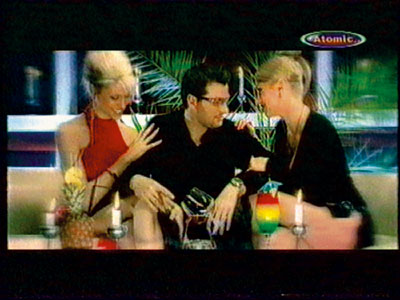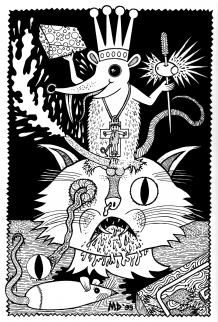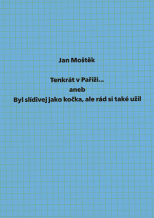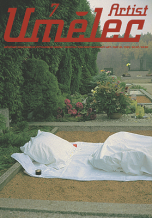| Umělec magazine 2004/1 >> Oh baby you’re not bad at all — commercial Romanian music videos | List of all editions. | ||||||||||||
|
|||||||||||||
Oh baby you’re not bad at all — commercial Romanian music videosUmělec magazine 2004/101.01.2004 Matei Bejenaru | videos | en cs |
|||||||||||||
|
Ten years ago, during the World Football Championship in America, when the Bulgarian and the Romanian teams were winning one game after another, the euphoria of millions of viewers back home was boundless. Bulgaria’s victory over Germany in the quarterfinal helped the Bulgarians forget that superstar Hristo Stoicikov, who was playing for CF Barcelona, spoke in Spanish when interviewed by the Bulgarian media. The players who had defeated the Germans became national symbols overnight and a photograph of the Bulgarian football team became the company logo for Balkan Air, suddenly appearing all over Europe in the windows of travel agencies.
Romania’s victory over Argentina in the final eight unleashed a great spontaneous wave of joy in all the cities of the country. So one can only imagine the backlash of anger over the malicious comments by a correspondent of the well-known French sports paper L’Equipe when he called our players “les gitans roumains” (the Gypsy Romanians). In the summer of 1994 at the rostrum of the Romanian parliament it was emphasized that the entire Romanian people had been offended. Four years later, at the world championship in France, our players set out to show the French that they had not forgotten the “compliments” — after passing the preliminary group, they all dyed their hair yellow. Although this “transfiguration” failed to bring them luck (the “new Swedes” lost the following game and were eliminated from the competition) it set off an explosive trend among teenagers living in the Romanian workers’ neighborhoods. In those days, kids with black eyebrows and blond hair, dyed with the cheapest liquids on the market, patterned their behavior on their heroes in the world of soccer. They were under the spell of the Romanian player’s “myth,” of the man born into a poor neighborhood who went on to play for Real Madrid or Chelsea and had a yearly income of millions of dollars. In the following years, things changed. A new influx of TV shows and stars broke up older trends, and advertising began slamming viewers with luxurious site-specific folklore. And then came the Romanian music industry. Today there are a handful of music production companies and a few specialized television stations (MTV – Romania and Atomic TV), which constantly struggle to tune in to the demands of the Romanian audience. If MTV-Romania mainly patterns its programming along the lines of the international station, broadcasting most of the music from abroad, then Atomic-TV specializes in home-grown production, which has also meant accepting the compromises necessary to maintain an unsophisticated audience. It’s no accident that the station flashes SMS messages sent in by viewers onto the screen during all its programs (fucking, fucking…, hidden prostitution...). In writing this article, I gathered information by watching the programs broadcast by Atomic TV for a week, choosing a few music videos that are significant in my analysis of how popular culture, and especially music videos, reflects different social problems in Romanian society. The sweet country life Fără zahăr (No Sugar) is a hip-hop band that sings (speaks) with dark humor about Romanian village life. Horses, cows, wagons, sheep, old women raped by their alcoholic nephews, poverty, dirty joints, black and white TVs from the ’70s, knife and axe fights, this is the “arsenal” that can be seen in the videos of these young men who come from Moldavia, the poorest and most rural area of Romania. Consciously or not, their music speaks about archaic rural life in Romania, and the issue of Romanian society in its process of modernization and the emancipation of the villages and small towns. In this autarchic and traditional area, which covers half of the Romanian territory and represents 45% of its population, the main activity is sustenance agriculture, which is an entirely inefficient form of farming from an economic point of view. A friend of mine from Sweden once told me that in Western societies humans are the most important capital but in post-communist societies, people and their mentalities are nothing but a problem (the more people, the more problems to solve). And Romania has to emancipate half of its population, which is no easy task. From underground reggae to higher-ground Gypsy music “You can be White or you can be Black You can be Romanian or you can be Gypsy The world has got to understand We all have the same blood…... Ooooh!” I could not agree more to what Pacha Man, Dru Klein and Mo’Weed sing in reggae rhythm. A video, shot in the poor areas on the fringes of Bucharest, shows barefoot children playing soccer on a mound of waste, at peace with nature and poverty. The musicians, who have adopted the classical Bob Marley look, sing to us – during a break between two barbecues of meat rolls and mixed grills – about harmony and equality among people and remind us once again of Gypsies in general. This ethnic group is the largest minority in Romania (unofficial statistics say there are over two million gypsies, approximately 10% of the population), and their integration, alongside the exportation of children through adoption, is an urgent social issue that the Romanian government has to deal with in the coming years. Let’s talk in particular about two famous Gypsies in Romania: Adrian Copilu’ Minune (Adrian the Wonder Child) and Vali Vijelie (Vali the Stormy Man). They both became rich and famous by singing manele, a type of traditional Gypsy music adapted to urban folklore. The singers need to be in exceptional physical shape in order to bear the sheer weight of gold in bracelets, watches, chains and other accessories that adorn their bodies. The electronic organ has now replaced the classical dulcimer their grandfathers once played; their lyrics are simple and talk about power, falling in love at first sight…with money and expensive cars. Their music is kitsch and reflects the “emancipation” and urbanization of Gypsies, and has poisoned the minds of millions of Romanians as it blasts from countless clubs and restaurants. The demand for their cassettes and CDs is high and Atomic TV promotes their videos featuring the insatiable and ubiquitous belly-dancing girls. Bad sexy girls, gangsters and Balkan hip-hop No doubt the striptease dancers that haunt Bucharest nightclubs have good contacts, and they often turn up “shaking their booty” in the music videos of neighborhood boys who came to be overnight hip-hop artists. During communism, Romania transformed into a “country of project housing,” to which the peasants were moved and they were transformed instantly into workers. The frustration generated by the enormous social polarization of the last decade and by the spread of corruption has caused hatred towards official figures (in Romania corruption in the police force is an insidious reality), and politicians have now become the favorite targets of the most successful hip-hop bands in Romania: BUG Mafia and The Parasites. Fourteen years after the fall of communism, the social problems of the workers’ neighborhoods are far from being solved. The high rate of unemployment and the lack of future prospects for young people have forced them to work or to steal abroad. On request various organized channels can now get you a photo or video camera stolen in Germany or France for a fraction of the retail price. “You steal abroad all that you can Now you play the macho man Oh baby you’re not bad at all.” These are the “meaningful” lyrics in a song by the band Sexxy. The group consists of two girls who dyed their hair blonde to satisfy the expectations of pimps, smugglers, thieves in Germany and many neighborhood teenagers. Both sexy and bad, they show us, together with Fizz — the gigolo of Romanian hip-hop — how fast one can spend money earned the night before. In recent time the visual popular culture in Romania has become a “mirror” of the transforming society, a society that was utterly destroyed during the Ceausescu communist dictatorship. More than a third of the Romanian population was moved from the countryside into the cities, where the peasants were forced into the role of worker. Many of these people are now unemployed, and this has become a big issue for a Romania which wants to join the EU in 2007. Their children are now the viewers of these videos and their lack of education has an influence on determining the quality and level of these videos, which are turned out by film professionals. And as I watch these low-budget music videos I think of all the young directors and graduates of the Theater and Film Academy in Bucharest, who are working in the music production companies and waiting for better days, for more sophisticated and — why not — richer viewers/consumers…
01.01.2004
Recommended articles
|
|||||||||||||
|
04.02.2020 10:17
Letošní 50. ročník Art Basel přilákal celkem 93 000 návštěvníků a sběratelů z 80 zemí světa. 290 prémiových galerií představilo umělecká díla od počátku 20. století až po současnost. Hlavní sektor přehlídky, tradičně v prvním patře výstavního prostoru, představil 232 předních galerií z celého světa nabízející umění nejvyšší kvality. Veletrh ukázal vzestupný trend prodeje prostřednictvím galerií jak soukromým sbírkám, tak i institucím. Kromě hlavního veletrhu stály za návštěvu i ty přidružené: Volta, Liste a Photo Basel, k tomu doprovodné programy a výstavy v místních institucích, které kvalitou daleko přesahují hranice města tj. Kunsthalle Basel, Kunstmuseum, Tinguely muzeum nebo Fondation Beyeler.
|






































 New book by I.M.Jirous in English at our online bookshop.
New book by I.M.Jirous in English at our online bookshop.
Comments
There are currently no comments.Add new comment